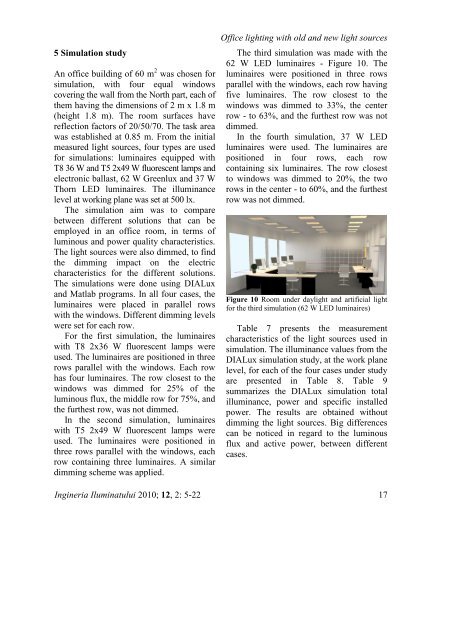ingineria iluminatului - Journal of Lighting Engineering - Prof. Florin ...
ingineria iluminatului - Journal of Lighting Engineering - Prof. Florin ...
ingineria iluminatului - Journal of Lighting Engineering - Prof. Florin ...
Create successful ePaper yourself
Turn your PDF publications into a flip-book with our unique Google optimized e-Paper software.
5 Simulation study<br />
An <strong>of</strong>fice building <strong>of</strong> 60 m 2 was chosen for<br />
simulation, with four equal windows<br />
covering the wall from the North part, each <strong>of</strong><br />
them having the dimensions <strong>of</strong> 2 m x 1.8 m<br />
(height 1.8 m). The room surfaces have<br />
reflection factors <strong>of</strong> 20/50/70. The task area<br />
was established at 0.85 m. From the initial<br />
measured light sources, four types are used<br />
for simulations: luminaires equipped with<br />
T8 36 W and T5 2x49 W fluorescent lamps and<br />
electronic ballast, 62 W Greenlux and 37 W<br />
Thorn LED luminaires. The illuminance<br />
level at working plane was set at 500 lx.<br />
The simulation aim was to compare<br />
between different solutions that can be<br />
employed in an <strong>of</strong>fice room, in terms <strong>of</strong><br />
luminous and power quality characteristics.<br />
The light sources were also dimmed, to find<br />
the dimming impact on the electric<br />
characteristics for the different solutions.<br />
The simulations were done using DIALux<br />
and Matlab programs. In all four cases, the<br />
luminaires were placed in parallel rows<br />
with the windows. Different dimming levels<br />
were set for each row.<br />
For the first simulation, the luminaires<br />
with T8 2x36 W fluorescent lamps were<br />
used. The luminaires are positioned in three<br />
rows parallel with the windows. Each row<br />
has four luminaires. The row closest to the<br />
windows was dimmed for 25% <strong>of</strong> the<br />
luminous flux, the middle row for 75%, and<br />
the furthest row, was not dimmed.<br />
In the second simulation, luminaires<br />
with T5 2x49 W fluorescent lamps were<br />
used. The luminaires were positioned in<br />
three rows parallel with the windows, each<br />
row containing three luminaires. A similar<br />
dimming scheme was applied.<br />
Office lighting with old and new light sources<br />
The third simulation was made with the<br />
62 W LED luminaires - Figure 10. The<br />
luminaires were positioned in three rows<br />
parallel with the windows, each row having<br />
five luminaires. The row closest to the<br />
windows was dimmed to 33%, the center<br />
row - to 63%, and the furthest row was not<br />
dimmed.<br />
In the fourth simulation, 37 W LED<br />
luminaires were used. The luminaires are<br />
positioned in four rows, each row<br />
containing six luminaires. The row closest<br />
to windows was dimmed to 20%, the two<br />
rows in the center - to 60%, and the furthest<br />
row was not dimmed.<br />
Figure 10 Room under daylight and artificial light<br />
for the third simulation (62 W LED luminaires)<br />
Table 7 presents the measurement<br />
characteristics <strong>of</strong> the light sources used in<br />
simulation. The illuminance values from the<br />
DIALux simulation study, at the work plane<br />
level, for each <strong>of</strong> the four cases under study<br />
are presented in Table 8. Table 9<br />
summarizes the DIALux simulation total<br />
illuminance, power and specific installed<br />
power. The results are obtained without<br />
dimming the light sources. Big differences<br />
can be noticed in regard to the luminous<br />
flux and active power, between different<br />
cases.<br />
Ingineria Iluminatului 2010; 12, 2: 5-22 17
















